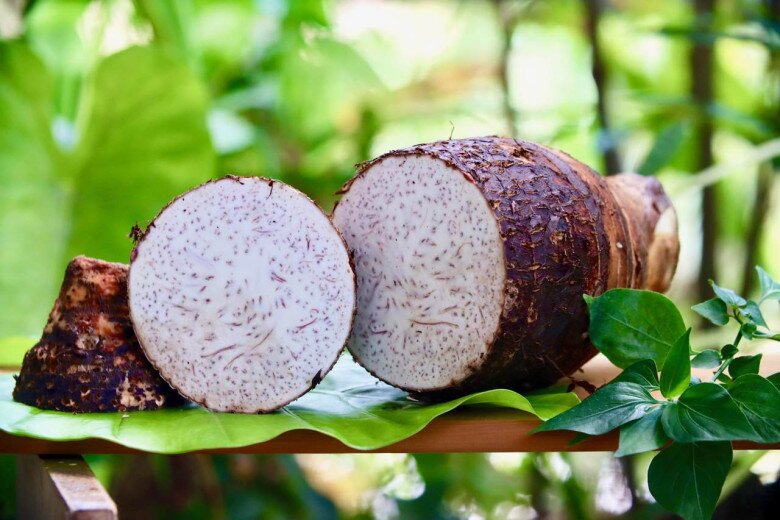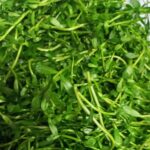## Taro: A Versatile and Nutritious Root Vegetable in Vietnamese Cuisine
Taro, also known as “khoai môn” in Vietnamese, is a widely cultivated crop in Vietnam, providing a year-round supply of starchy tubers. According to BS.CKII Huynh Tan Vu, Head of the Day Treatment Unit at Ho Chi Minh City University of Medicine and Pharmacy, Facility 3, the edible parts of taro are its corms and leaves.
In the past, taro was mostly a wild plant found along roadsides and in fields, and it was less popular due to the itching sensation it caused upon contact. Today, in addition to wild taro, there are many cultivated varieties with different colors available across the country.

Cultivated taro with white flesh is particularly recommended for its health benefits.
Dr. Vu cautions that wild taro, usually purple in color, is not as nutritious and may not be as safe to consume. He advises consuming only cultivated taro, which can be identified by its white sticky powder, slightly sweet taste, smooth texture, and cooling properties. This variety is believed to have regulatory effects on the internal organs, relieve flatulence, and nourish the body.
In Vietnamese cuisine, taro is a versatile ingredient used in a variety of dishes, including cakes, ice cream, sweet soups, and savory soups and stews with meat and fish. Dr. Vu highlights its ability to regulate internal organs, relieve flatulence, and nourish the body, making it a valuable ingredient in traditional remedies.
In folk belief, consuming taro is thought to ward off evil and bring good fortune. As a result, many people eat taro soup during the Mid-Autumn Festival, believing it will bring prosperity and blessings throughout the year.
Taro: A Good Source of Potassium, Fiber, and Vitamins
Dr. Vu emphasizes the nutritional benefits of taro, particularly its high potassium content, which helps regulate blood pressure and reduce the risk of hypertension. The fiber in taro promotes digestive health and prevents constipation. With 1.5g of fiber per 100g of taro, it meets 27% of the daily fiber requirement. This fiber content also contributes to a reduced risk of colorectal cancer, aids in detoxification, and lowers harmful cholesterol levels.
Additionally, taro is a good source of vitamins C and B6, which boost immunity and have anti-aging properties. It also contains over 17 types of amino acids, omega-3, and omega-6 fatty acids, benefiting cardiovascular health and contributing to overall disease prevention.
Traditional Remedies Using Taro
– Relief from Itchy Skin Conditions: Boil taro corms and use the water for bathing to soothe itchy skin.
– Treating Scalp Sores and Infections in Children: Crush a large taro corm and apply it as a poultice to the affected area.
– Combating Fatigue, Appetite Loss, and Thirst: Prepare a porridge with 200g taro, 50g yam, and 50g rice. This dish is believed to boost energy, enhance digestion, and is recommended for individuals experiencing fatigue, poor appetite, and excessive thirst.

Consuming taro during the Mid-Autumn Festival is considered auspicious and believed to bring good luck.
– Post-Illness Recovery and Nourishment: Cook a soup with 100g taro and 50g lean pork. This dish is believed to replenish the body, quench thirst, boost energy, and soothe the stomach. Alternatively, prepare a sweet soup with 250g taro, 50g Chinese dates, and 50g red sugar. Consume this in 3-4 servings throughout the day to nourish and rehydrate the body after an illness.
– Alleviating Restlessness, Poor Appetite, and Insomnia: Prepare a soup with 200g river crab, 60g taro, and a bunch of water spinach. Clean the crab, removing the gills and shell, and keeping the roe. Season with fish sauce and salt to taste. This dish is believed to benefit individuals experiencing restlessness, poor appetite, and insomnia.
– Addressing Physical and Mental Fatigue: Combine 300g taro, 100g lotus seeds, oil, and seasonings. Peel and soak the taro in salted water to remove mucilage. Soak the lotus seeds until soft, then blanch them. Sauté the taro briefly before adding water and cooking for about 10 minutes. Add the lotus seeds and simmer until both ingredients are soft. This dish is believed to improve brain function and alleviate memory loss associated with physical and mental fatigue.
– Relieving Allergic Skin Reactions and Joint Pain: Simmer 60g taro with 100g of pig trotter or spine bones for 2 hours. Consume this soup twice a day to dispel wind and dampness. It is believed to help with allergic skin reactions and joint pain.
– Treating Pimples and Ingrown Hairs: Mix equal parts taro and vinegar, boil, and crush into a paste. Apply this paste topically to the affected areas.
The Ultimate Crispy Pig Tail Treat: A Saigon Mom’s Special
Indulge in the ultimate crispy-skinned, deep-fried pork tail delight. The melt-in-your-mouth fatty meat, paired with a generous dip into a tangy tamarind sauce, creates an irresistible flavor profile that lingers long after the last bite. This mouthwatering dish is an unforgettable culinary experience.
The Ultimate Secret Ingredient to Transform Your Pho Noodle Soup: Unveiling a Memorable Culinary Experience
With this mouth-watering pho recipe, you’ll create a delicious, aromatic dish that will leave a lasting impression. The perfect blend of spices and herbs creates a broth that is both flavorful and comforting. This recipe is a surefire way to make a memorable meal that will keep you warm and satisfied.



































